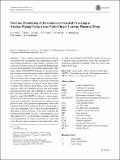On-Line Monitoring of Environment-Assisted Cracking in Nuclear Piping Using Array Probe Direct Current Potential Drop
Author(s)
Kim, Y.; Choi, S.; Yoon, J. Y.; Nam, W. C.; Hwang, I. S.; Bromberg, Leslie; Stahle, Peter W; Ballinger, Ronald G.; ... Show more Show less
Download10921_2015_Article_330.pdf (2.761Mb)
OPEN_ACCESS_POLICY
Open Access Policy
Creative Commons Attribution-Noncommercial-Share Alike
Terms of use
Metadata
Show full item recordAbstract
A direct current potential drop method utilizing array probes with measurement ends maintaining an equalized potential designated as equi-potential switching array probe direct current potential drop (ESAP-DCPD) technique has been developed earlier at Seoul National University. This paper validates ESAP-DCPD technique by showing consistency among experimental measurements, analytical solution and numerical predictions using finite element analysis (FEA) of electric field changes with crack growth in metals. In order to examine its viability as an on-line monitoring of environment assisted crack growth at the inner surface of piping welds, artificial inner surface cracks were introduced in a full-scale weldment mockup pipe and stainless steel metal mockup pipe. The weldment was joined by low alloy steel and stainless steel pipes. The pipes were monitored by using ESAP-DCPD in laboratory environments. Optimization of electrical wiring configuration has produced results with significantly reduced noise for adequately long period of time. Then optimized experimental results were compared with the FEA prediction results for the mockup to show a good agreement. Also a round-robin measurement has been made at three laboratories. It has been found that the developed ESAP-DCPD can detect circumferential cracks with a depth of 40 % of wall thickness in stainless steel with a good detectability for further growth behaviors. For axial cracks, however, the measurements showed poor detectability. Hence the developed ESAP-DCPD system can be used to monitor large circumferential cracks that existing non-destructive examination techniques often fail to detect until leakage takes place.
Date issued
2015-12Department
Massachusetts Institute of Technology. Department of Nuclear Science and Engineering; Massachusetts Institute of Technology. Plasma Science and Fusion CenterJournal
Journal of Nondestructive Evaluation
Publisher
Springer US
Citation
Yoon, J. Y. et al. “On-Line Monitoring of Environment-Assisted Cracking in Nuclear Piping Using Array Probe Direct Current Potential Drop.” Journal of Nondestructive Evaluation 35.1 (2016): n. pag.
Version: Author's final manuscript
ISSN
0195-9298
1573-4862